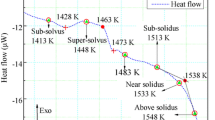Abstract
The process of obtaining a gradient structure by thermomechanical treatment (TMT) has been demonstrated using the example of a model disk workpiece made of the powder-metallurgy (PM) EP741NP nickel-based superalloy. The TMT included the main deformation leading to the development of recrystallization and the formation of a fine-grained microstructure, heat treatment in a gradient temperature field, additional deformation, and final strengthening heat treatment. In the disk workpiece after TMT, a gradient structure was obtained: a “necklace” structure in the peripheral part and a fine-grained “microduplex” structure in the center. The estimation of mechanical properties of samples cut out at different distances from the axis of symmetry of the disk workpiece showed that the central part of the disk is characterized by enhanced strength and ductility, and the peripheral part possesses enhanced high-temperature strength and impact toughness. The obtained results indicate that the approach used is promising for achieving a gradient structure and gradient mechanical properties in disks made of PM nickel based superalloys.






Similar content being viewed by others
REFERENCES
J. Gayda, “Dual microstructure heat treatment of a nickel-base alloy,” Tech. Memorandum NASA TM 211168, November 2001.
L. B. Ber, “The formation of particles of the γ'-phase in the process of the quenching cooling of granulated alloy EP741NP. Construction of TTT diagrams of decomposition of the γ solid solution,” Tekhnol. Legk. Splavov, No. 3, 77–88 (2009).
S. V. Ovsepyan, B. S. Lomberg, M. M. Bakradze, and M. N. Letnikov, “Heat treatment of deformable heat-resistant nickel alloys for GTE disks,” Vestn. MGTU im. N.E. Baumana. Ser. Mashinostr., Spets. Vypusk “Perspektivnye Konstruktsionnye Materialy i Tekhnologii”, 122–130 (2011).
G. S. Garibov, N. M. Grits, E. A. Fedorenko, D. A. Egorov, A. M. Volkov, and A. A. Chudinov, “Investigation of the material of the workpieces of disks with variable structure from granules of heat-resistant nickel alloys, manufactured according to the technology of direct GUI,” Tekhnol. Legk. Splavov, No. 4, 41–49 (2011).
D. A. Egorov, G. S. Garibov, N. M. Grits, A. Kazberovich, and N. A. Ryzhova, “The study of the material of disc blanks with a variable structure made of granules of heat-resistant nickel alloys manufactured by direct ISU technology,” Tekhnol. Legk. Splavov, No. 3, 67–77 (2014).
B. S. Lomberg, M. M. Bakradze, E. B. Chabina, and E. V. Filonova, “The relationship of the structure and properties of high-temperature nickel alloys for gas turbine engine disks,” Aviats. Mater. Tekhnol., No. 2, 25–30 (2011).
M. L. Kuz’menko, V. S. Chigrin, and S. E. Belova, Static Strength of Blades and Disks of Compressors and Turbines of the GTE, Tutorial (RGATA, Rybinsk, 2005).
G. V. Gorobets, “On the calculation of the temperature distribution on the disks of axial compressors of gas turbine engines,” Prom. Teplotekh. 26 (5), 37–40 (2004).
O. Kh. Fatkullin, V. I. Eremenko, O. N. Vlasova, and N. M. Grits, “Improving the mechanical properties of granular heat-resistant alloys due to alloying and pressure treatment,” Tekhnol. Legk. Splavov, Nos. 5–6, 149–155 (2001).
R. J. Mitchell, J. A. Lemsky, R. Ramanathan, H. Y. Li, K. M. Perkins, L. D. Connor, “Process development & microstructure & mechanical property evaluation of a dual microstructure heat treated advanced nickel disc alloy,” TMS, 347–356 (2008).
T. P. Gabb, P. T. Kantzos, J. Telesman, J. Gayda, C. K. Sudbrack, and B. Palsa, “Fatigue resistance of the grain size transition zone in a dual microstructure superalloy disk,” Int. J. Fatigue 33, 414–426 (2011).
S. A. Kononov, A. S. Perevozov, and B. A. Kolachev, “Structure and mechanical properties of a granulated EP741NP alloy produced by a technology including hot isostatic pressing and metal forming,” Russ. Metall. (Engl. Transl.) 2007, 415–417 (2007).
G. S. Garibov, “Pellet metallurgy is the basis for the development of advanced aircraft engines,” Tekhnol. Legk. Splavov, No. 1, 66–78 (2007).
Yu. A. Nozhnitskii, “Problems of use of granular alloys in promising GTE,” Tekhnol. Legk. Splavov, No. 4, 13–20 (2007).
V. G. Sklyarenko, M. V. Bubnov, D. A. Ponomarenko, N. V. Moiseev, and Yu. V. Malashenko, “Making disc blanks from EP741NP alloy using the HIP method with subsequent deformation,” Metallurgiya Mashinostroeniya, No. 5, 41–44 (2008).
A. G. Beresneev, A. V. Logunov, and A. I. Logacheva, “Problems of improving the quality of superalloys produced by metallurgy of granules,” Vest. MAI 15 (13), 83–89 (2008).
Superalloys II: High-Temperature Materials for aerospace and Industrial Power, In 2 vols., Ed. by Ch. T. Sims, N. S. Stoloff, and W. C. Hagel’ (Wiley–Interscience, New York, 1987; Metallurgiya, Moscow, 1995).
V. A. Valitov, F. Z. Utyashev, and R. G. Baimurzin, “Effect of rolling conditions on the structure and properties of discs of EP962 heat-resistant nickel alloy,” Aviats. Promyshl., Nos. 11–12, 19–24 (1994).
N. E. Zorov, “Thermomechanical treatment of superalloys,” Tekhnol. Legk. Splavov, No. 7, 61–73 (1981).
M. N. Menon and W. H. Reiman, “Tensile behavior of Rene 95 in the thermomechanicaly processed forms,” Metall. Trans. A 6, 1075–1085 (1975).
C. E. Shamblen, P. E. Allen, and P. E. Walker, “Effect of processing and microstructure on Rene 95,” Metall. Trans. A 6, 2072–2083 (1975).
A. S. Kleshchev, N. N. Korneeva, A. B. Notkin, and O. M. Yurina, “Changes in the structure of heat-resistant nickel alloys of type EP742 during thermomechanical processing,” Fiz. Met. Metalloved. 47, 548–557 (1979).
A. A. Ganeev and V. A. Valitov, “The formation of ultrafine-grained structure in nickel alloy EP741NP during hot deformation in (γ + γ') region,” Pis’ma Mater., No. 5, 152–155 (2015).
ACKNOWLEDGMENTS
The experimental studies were carried out using the equipment of the Center of Collaborative Access of the Institute for Metals Superplasticity Problems, Russian Academy of Sciences.
Funding
This work was supported by the Russian Scientific Foundation (project no. 18-19-00685).
Author information
Authors and Affiliations
Corresponding author
Additional information
Translated by O. Golosova
Rights and permissions
About this article
Cite this article
Ganeev, A.A., Valitov, V.A., Utyashev, F.Z. et al. Effect of Thermomechanical Treatment on the Formation of Gradient Structure and Mechanical Properties in a Disk Made of Powder-Metallurgy Nickel-Based Superalloy. Phys. Metals Metallogr. 120, 410–416 (2019). https://doi.org/10.1134/S0031918X19040057
Received:
Revised:
Accepted:
Published:
Issue Date:
DOI: https://doi.org/10.1134/S0031918X19040057




